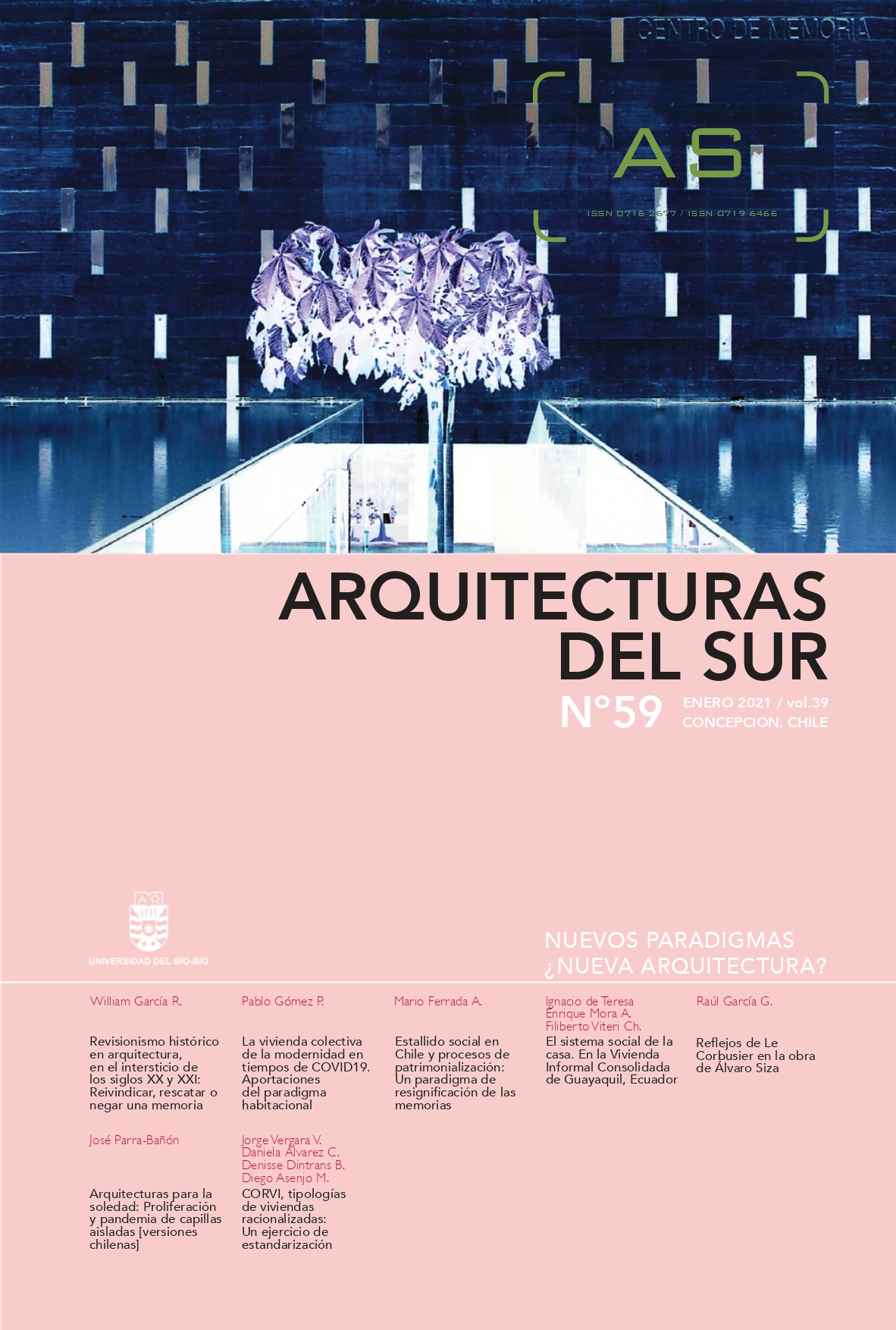La vivienda colectiva de la modernidad en tiempos de COVID19 aportaciones del paradigma habitacional
DOI:
https://doi.org/10.22320/07196466.2021.39.059.02Palabras clave:
Modernidad, higiene, equipamiento comunitario, conjuntos habitacionales, áreas verdesResumen
La habitación colectiva de la modernidad generó un paradigma de diseño urbano-arquitectónico, que incorporaba espacios cuyo diseño fomentaba, de acuerdo con los arquitectos de la modernidad, salud e higiene mediante la circulación de aire puro, iluminación y ventilación naturales al interior de las viviendas, al igual que en los espacios compartidos y de circulación característicos de esa tipología habitacional. Esos elementos de diseño parecen ser útiles en la reducción de contagios del virus SarsCov2 y que actualmente afecta al mundo entero. Para verificar este supuesto, se realizó un trabajo de campo y en línea con habitantes del Centro Urbano Presidente Alemán (CUPA), conjunto representativo de la modernidad arquitectónica en la Ciudad de México. Mediante reconstrucciones volumétricas y cuestionarios en línea se analizaron los elementos de diseño que materializan los ideales modernos orientados a garantizar espacios exteriores e interiores sanos; se evaluó la utilidad de los equipamientos colectivos, espacios de circulación y el diseño de las cuatro tipologías de vivienda que tiene el conjunto. Los resultados del estudio y la ausencia de casos de COVID19 en el CUPA, ayudan a demostrar la validez que recobra la arquitectura moderna en la pandemia mundial, así como la importancia de las lecciones del pasado para integrar nuevos paradigmas de diseño para una arquitectura post-Covid.
Descargas
Citas
Congresos Internacionales de Arquitectura Moderna (CIAM) (1933). Carta de Atenas.
DE GARAY, G. (2004). Modernidad habitada: Multifamiliar Miguel Alemán ciudad de México, 1949-1999. México: Instituto Mora.
DUHAU, E. Y GIGLIA, A. (2004). Las reglas del desorden. Habitar la metrópoli. México: Siglo XXI Editores, UAM Azcapotzalco.
Gobierno de la Ciudad de México (12 de octubre de 2020). Mapa COVID Ciudad de México.
Recuperado de https://datos.cdmx.gob.mx/pages/covid19/
GÓMEZ PORTER, P. F. (2020). Gestión de unidades habitacionales de la modernidad en México.
Gremium, 7(13), 39-50.
INEGI (2016). Inventario Nacional de Vivienda 2016. Obtenido de https://www.inegi.org.mx/app/mapa/inv/
MONTANER, J. M. (2015). La arquitectura de la vivienda colectiva. Políticas y proyectos en la ciudad contemporánea. Barcelona: Reverté.
MORAWSKA, L. Y CAO J. (2020). Airborne transmission of SARS-CoV-2: The world should face the reality. Environment International, 139.
MUXÍ MARTÍNEZ, Z. (2020). Viviendo en pandemia. Reflexiones en torno al habitar y la salud.
Topofilia, Revista de Arquitectura, Urbanismo y Territorios, (21), 2-13.
PANI, D. M. (1950). Centro urbano “Presidente Alemán”. Revista Arquitectura México, (30), 263-275.
PANI, D. M. (1952). Los multifamiliares de pensiones. México: Arquitectura.
SAMBRICIO, C. (2012). Ciudad y vivienda en América Latina 1930-1960. Madrid: Lampreave.
UNESCO (1972). Convención del patrimonio mundial, cultural y natural. París: Organización de las Naciones Unidas para la Educación, la Ciencia y la Cultura.
UNESCO (2008). Directrices prácticas de aplicación de la convención del patrimonio mundial, cultural y natural. París: Organización de las Naciones Unidas para la Educación, la Ciencia y la Cultura.
UNESCO (12 de octubre de 2020). World Heritage Centre. En: Obra arquitectónica de Le Corbusier – Contribución excepcional al Movimiento Moderno. Recuperado de https://whc.unesco.org/en/list/1321
VILLAVICENCIO, J. (2006). Conjuntos y unidades habitacionales en la Ciudad de México: en busca de espacios sociales y de integración barrial. México: Red Nacional de Investigación Urbana.
Descargas
Publicado
Cómo citar
Número
Sección
Licencia
Derechos de autor 2021 Pablo Francisco Gómez Porter

Esta obra está bajo una licencia internacional Creative Commons Atribución-CompartirIgual 4.0.
El contenido de los artículos que se publican en cada número de Arquitecturas del Sur, es responsabilidad exclusiva de los autores y no representan necesariamente el pensamiento, ni comprometen la opinión de la Universidad del Bío-Bío.
Las/os autoras/es conservarán sus derechos de autoría, sin embargo, garantizarán a la revista el derecho de primera publicación y difusión de su obra. La publicación del artículo en Arquitecturas del Sur está sujeta a la Licencia de Reconocimiento de Creative Commons CC BY-SA que permite a otros Adaptar: remezclar, transformar y construir sobre el material para cualquier propósito, incluso comercialmente, Compartir: copie y redistribuya el material en cualquier medio o formato, siempre y cuando se reconozcan la autoría y la primera publicación en esta revista citando correctamente, así como también sus nuevas creaciones estén bajo una licencia con los mismos términos.













 Programa de Información Científica/Concurso Fondos de Publicación de Revistas Científicas 2018/ Proyecto Mejoramiento de Visibilidad de Revistas UBB (Código:FP180007)
Programa de Información Científica/Concurso Fondos de Publicación de Revistas Científicas 2018/ Proyecto Mejoramiento de Visibilidad de Revistas UBB (Código:FP180007) 
